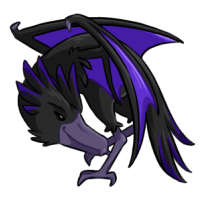 Scavengers Serendipis scavis
Scavengers Serendipis scavis
Blighted Wilds

APPEARANCE
Sizewise, most scavengers range from the size of a vulture to the size of an ostrich. Violet blight scavengers are the most abundant type, however, scavengers come in a number of different appearances, some of which seem to be influenced by seasons or even by strange magics. To see the currently available different types of scavengers, please visit the Encyclopedia.
HABITAT
Most wild scavengers live in the Blighted Wilds. They consume the bodies of deceased creatures. Scavengers were once abundant throughout Aerius, but due to the threat of necrosis, many of them have been culled due to the fears of other nations. The wild populations of scavengers that remain outside of the Blighted Wilds are tame and looked after by caretakers who work to keep them living within the borders of their nation and/or continent.
Behaviors
Scavengers are named specifically for their behavior and ecological role. They scavenge. In wild scavengers this ia rather straightforward, as they scavenge on dead bodies of other animals. For domesticated scavengers, it is encouraged to simulate this behavior by hiding their food in particular ways so they can engage in instinctive behaviors while feeding. If they are not given the opportunity to do this, it is very likely they will wind up attempting to scavenge from their owner's refrgerator and/or pantry.
DIET
Wild scavengers eat pretty much anything, most dominantly they consume corpses, even eating bones. Domesticated scavengers will do this as well, however, they can also consume other things. A favorite treat of domesticated scavengers is a large bowl full of ice, frozen mushrooms, and frozen meat.
ROLES
Scavengers are a carrion bird. Their consumption of corpses is very important for the environment, and is typically an important way for diseases to be taken out of circulation, as they are immune to most pathogens. It is theorized that this is why they are one of the few species on Aerius that has been able to adapt to necrosis and be able to continue to reproduce even with necrosis, however it has been difficult to study.
REPRODUCTION
Eggs.
LIFESPAN
Due to the effects of magic, scavengers owned by another species will live for as long as their owner does. A wild scavenger will typically live between ten to thirty years.
CORRUPTION
Scavengers can contract necrosis, however, they seem to process it differently from other animal species. They are still able to reproduce with necrosis, and seem to be able to switch between different variants with no impacts on whether they are corrupt, cured, or pure. Researchers are extremely interested in them as a potential way to improve the cure's efficacy, and to potentially restore the ability to reproduce. (Of course, other researchers in the Blighted Wilds are interested solely in them as a method to restore the ability to reproduce to corrupted dextroluma).

